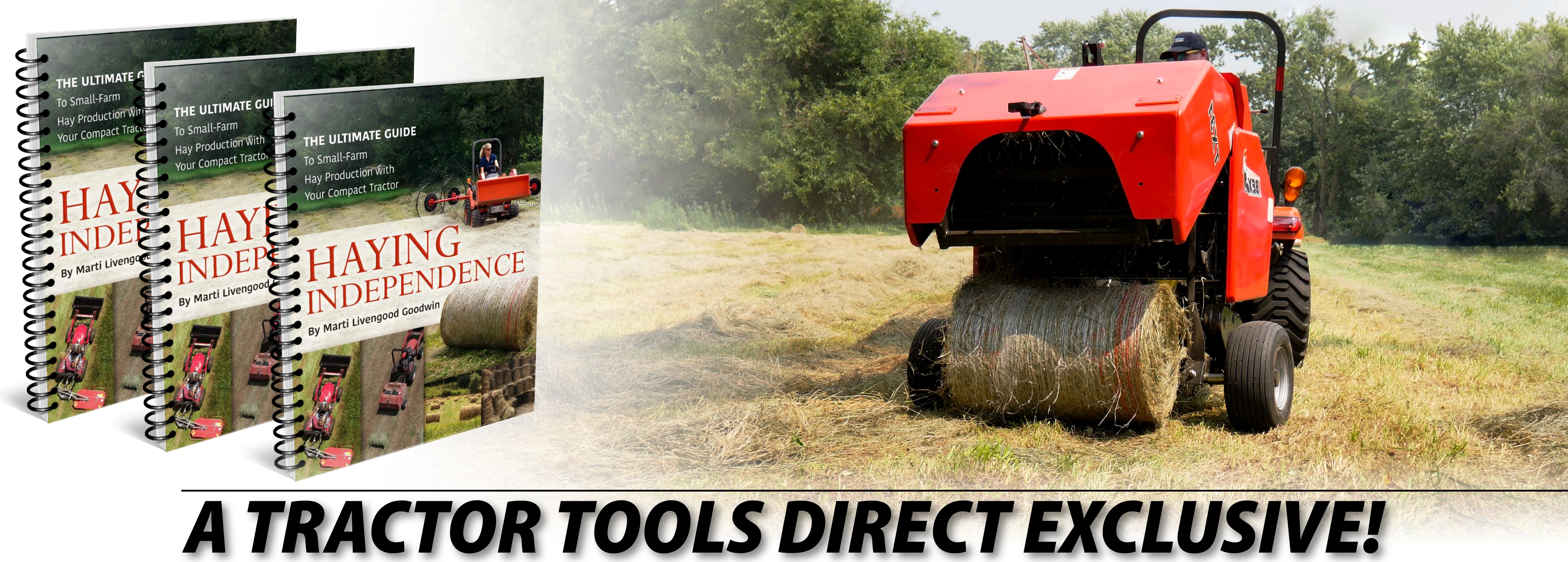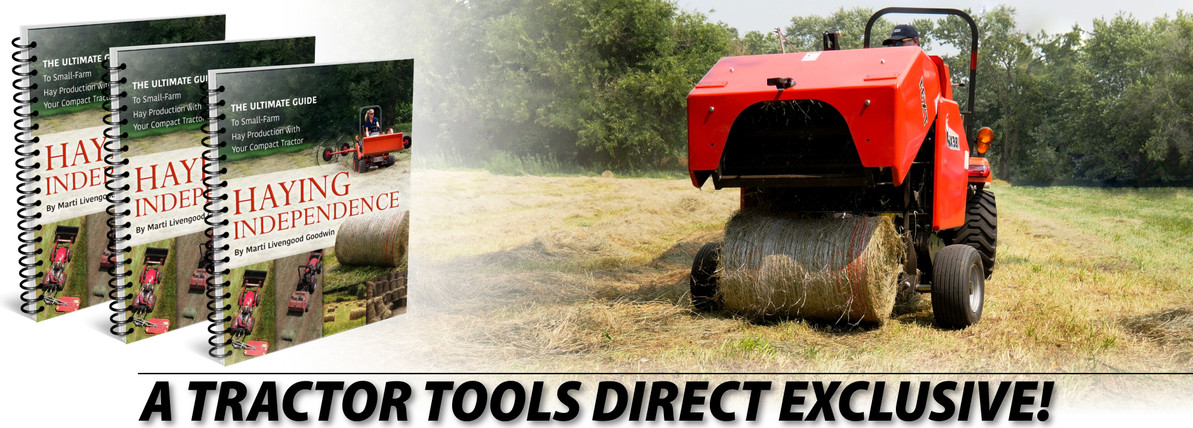Introducing Tractor Tools Direct’s Amazon Best-Selling Author!

Have you been enjoying our company's blogs, how-tos, and other instructional information? Then we have great news for you! Tractor Tools Direct co-owner and blog writer Marti Livengood Goodwin has published a book compiling much of this information in one place.
Haying Independence: The Ultimate Guide to Small-Farm Hay Production provides a step-by-step guide to achieving haying independence on your small farm. Learn how to successfully:
- Assess your farm’s forage needs.
- Choose, repair, and maintain hay equipment sized for your farm including mowers, rakes, tedders, and balers.
- Follow the baling process of mowing, curing, tedding, raking, and baling.
- Store, feed, and market your hay.
Marti spent the first forty years of her life on a small farm in Vigo County, Indiana. Over the course of that time the farm maintained both a poultry and sheep operation and produced grain and forage in-house for its livestock. Marti and her husband took the knowledge they gained on the farm and became dealers of small-farm machinery in 2009. This venture quickly resulted in the opening of Tractor Tools Direct in 2013, America’s premier online source for small-farm hay equipment.
Haying Independence: A Guide to Small-Farm Hay Production, already an Amazon best seller, is now available for purchase on our website in two formats and can be found at this link.
Read on to enjoy an excerpt from the book.
Chapter 1
Our Own Adventures in Small-Farm Haying
I should have guessed that my first published book would be about baling hay. I should have seen it coming on those hot and dusty afternoons when, at the age of ten, my father had me up on the old Deutz tractor running the baler. In order to save a few bucks on hay help, he would do the heavy work of stacking bales while I ran the baler. Penny-pinching tactics like that helped him pay for my liberal arts education where the task of writing lines of prose on paper became as routine to me as raking rows of dry grass in a hay field.
The City Mouse Meets the Country Mouse
While those early days set the scene, this story began in 1995. That’s when my husband, Pat—whom I’ll call “my city mouse”—joined not only my family but also my family farm. An engineer and lifelong suburbanite, he quickly learned to feed and handle sheep, manage pastures, and repair machinery along with many other jobs that a few years before he would have never imagined himself doing.
Pat found the most rewarding task to be mowing, tedding (spreading hay for drying), raking, and baling hay. At first, I thought the long hours he spent in the hay field might simply be an attempt to escape the demands of four tiny kids and their frazzled mom. Maybe they were, but I could tell that he truly loved it. His engineering mind found taming the wild summer grasses to be a gratifying challenge, carefully aligning the windrows (lines of raked hay) and baling the forage into perfect rectangular packages. The time alone to think without interruption and take in the scents of summer also quickly became a tonic for his demanding life as a young, working dad.
My family, especially my own overworked father, was excited and eager to train a new set of hands to help with the sheep and hay-selling businesses. And as it turns out, the fact that this indoctrination occurred so completely and seamlessly was a good thing. Though things went without a hitch (pardon the pun—it’s also a family thing) for several years, everything changed in the spring of 2008.
A Change in Plans
That April, my father, one of the hardiest men you could ever know, was diagnosed with acute myeloid leukemia. With this diagnosis, his health deteriorated rapidly and never rebounded before his death in October 2009. Even during the eighteen months he lived with cancer (and certainly after his death), Pat and I picked up even more, and eventually all, of the farm responsibilities.
Of these responsibilities, hay-baling soon became the most frustrating, not because of the actual task but because of the 40-to-50-year-old tractor and hay equipment that my father had always relied upon to accomplish the task. Actually, it would be more appropriate to say that the equipment had come to rely upon my dad and his countless hours of expertise and extra time to keep the antiquated machinery running. Though Pat had gained the knowledge to repair this equipment, with four kids, a full-time job, and a myriad of other farm chores to complete, the time necessary to keep this aged equipment running was a commodity he just did not have.
To add to this problem, we quickly discovered that the size of the bales our baler produced had become a rather weighty problem (oops, sorry…did I do it again?). Though Pat could easily handle the 60-to-70-pound bales, the kids (our pre-teen hay help) and I, who would now need to help even more with the baling and feeding of these bales, could not. This led Pat to wonder: Was it necessary that the bales on our farm or for our business be that heavy? “No,” was his conclusion. The demographics on the farm had changed. It was time for him to begin his search for something different…
Our Quest for New Equipment
Thus began our quest to replace the family’s 50-year-old Massey Ferguson tractor and International Harvester baler. Though revered and romanticized family heirlooms, this machinery had become inefficient and uneconomical for our farm and business needs. To make an educated choice on the most suitable replacements, Pat determined the criteria a new tractor, baler, and other implements would need to meet in order to fulfill the evolving needs of our farm. The process he used was very much like the process he recommends (in Chapter 3) to any equipment buyer before making a decision on the tools and implements in which to invest.
By the next hay season, we had purchased a complete compact hay equipment package – including implements not easily found at your local tractor dealership.
We have not once looked back or second-guessed these purchases. In fact, we fell in love with our new equipment so much that by the summer of 2009, we became a dealer of small-farm equipment. Jump ahead another decade, and Pat and I now own the largest e-commerce company of its kind, specializing in compact hay equipment for small farms.
So, what does this have to do with you? Everything!
After spending years figuring out small-farm hay production ourselves and helping countless others do it too, I have now compiled the countless blogs and educational content our company has produced into the guide you now hold in your hands.
Everything you’re about to learn inside this book is based on our adventures in small-farm haying over the past three decades. The successes. The failures. As well as everything we’ve learned from our loyal customers who trust us to provide the very best information and tools available.
Our goal is to help folks like you get started on your journey to small-farm Haying Independence!
Enjoy what you just read? Want more? Follow this link to purchase your copy of Haying Independence: The Ultimate Guide to Small-Farm Hay Production today!
Recent Posts
-
Rototillers vs. Power Harrows: Which Tool is Best for Your Soil?
Fall might seem like an odd time to talk about planting, but there really is no better time to t …Oct 27th 2025 -
Fall Hay Equipment Checklist: Prepare Your Machinery for Winter
After a busy and productive hay season, it’s easy to park your equipment in the barn and call …Oct 14th 2025 -
Flail Mower Face-Off: Hammer Blades or Y Blades?
When it comes to flail mowers, the choice of blade type plays a crucial role in their performa …Sep 29th 2025




